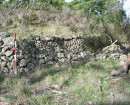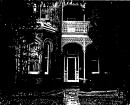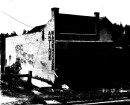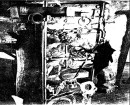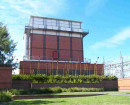Back to search results
VOLUNTEER DEFENCE CORPS (VDC) TAMBO TRENCHES
GREAT ALPINE ROAD ENSAY, EAST GIPPSLAND SHIRE
VOLUNTEER DEFENCE CORPS (VDC) TAMBO TRENCHES
GREAT ALPINE ROAD ENSAY, EAST GIPPSLAND SHIRE
All information on this page is maintained by Heritage Victoria.
Click below for their website and contact details.
Victorian Heritage Register
-
Add to tour
You must log in to do that.
-
Share
-
Shortlist place
You must log in to do that.
- Download report

2023, East wall of Trench 7












On this page:
Statement of Significance
Volunteer Defence Corps (VDC) Tambo Trenches is located on Wurundjeri Country.
What is significant?
The Volunteer Defence Corps (VDC) Tambo Trenches (1942) a linear site comprising a network of approximately 17 trenches located on a densely vegetated ridge 6-8 metres above the Great Alpine Way, formerly the Omeo Highway.
How is it significant?
The Volunteer Defence Corps (VDC) Tambo Trenches is of historical and archaeological significance to the State of Victoria. It satisfies the following criterion for inclusion in the Victorian Heritage Register:
Criterion A
Importance to the course, or pattern, of Victoria’s cultural history.
Criterion B
Possession of uncommon, rare or endangered aspects of Victoria’s cultural history.
Criterion C
Potential to yield information that will contribute to an understanding of Victoria’s cultural history.
Criterion H
Special association with the life or works of a person, or group of persons, of importance in Victoria’s history.
Why is it significant?
The Volunteer Defence Corps (VDC) Tambo Trenches are of historical significance for their capacity to demonstrate the civil defence movement in Australia during World War II (1939-45). Constructed by members of the VDC Ensay Unit, they demonstrate the heightened anxieties of Australians from early 1942 about air attack and invasion. The trenches speak to the Australian Government’s mobilisation of local communities to prepare for war, including those on the vulnerable eastern coast of Victoria. The trenches are a striking example of the readiness of civilian Victorians to build defensive infrastructure, train for guerrilla warfare and defend their part of the state with the resources available to them.
(Criterion A)
The Volunteer Defence Corps (VDC) Tambo Trenches are of historical significance as a rare surviving example in Victoria of purpose-built defensive trenches constructed during World War II (1939-45).
(Criterion B)
The Volunteer Defence Corps (VDC) Tambo Trenches are of archaeological significance for their potential to yield knowledge of significance to Victoria that will allow a greater understanding the activities of the VDC and the civil defence of Victoria.
(Criterion C)
The Volunteer Defence Corps (VDC) Tambo Trenches are of historical significance for their association with the VDC. This Commonwealth civil defence organisation made an important contribution to the defence of the Victorian homefront during World War II. Few purpose-built training and defensive sites constructed by VDC units survive. This place, strategically constructed using the topography of the land to best advantage, allows the work of the VDC to be particularly well understood, including the role of local knowledge in homefront defence.
(Criterion H)
Show more
Show less
-
-
VOLUNTEER DEFENCE CORPS (VDC) TAMBO TRENCHES - History
World War II (1939-45)
During World War II, Australians lived with a fear that the country was vulnerable from attack by Japan. This was based on Japan’s rapid advance from late 1941 southward across countries in southeast Asia. On 3 September 1939 Australia entered the war, following the United Kingdom. Japan joined the war on 22 September 1940 after invading French Indochina and formed an alliance with Germany. On 8 December 1941, Japan attacked Pearl Harbour, bringing the USA into the war. Japan continued south through Malaya and Singapore fell on 15 February 1942. The day after, Prime Minister John Curtin addressed the nation declaring that Australia was vulnerable to invasion:
The protection of this country is no longer that of a contribution to a world at war but the resistance to an enemy threatening to invade our own shore.... It is now work or fight as we have never worked or fought before.... On what we do now depends on everything we may like to do when this bloody test has been survived.The Japanese threat to Australia continued and on 16 February 1942, the Australian-controlled territory of New Guinea was attacked. Darwin was bombed on 19 February 1942 killing more than 230 people. Japanese bombing raids followed across northern Australia, and submarine attacks occurred at Sydney Harbour in May 1942 and Newcastle in June 1942. Japanese submarines were also known to be operating off the south-east coast. Within a few months, the Pacific War had arrived on Australia’s doorstep.
The defence of Australia
The Japanese attacks lead many to believe that Australia may be in danger of invasion, and the Government took steps to prepare the homefront. It introduced blackout restrictions, issued air raid instructions, and built defensive infrastructure along some beaches on the east coast. All men, women and children, were urged to take the threat seriously and prepare for air and sea attack. In 1941 the Department of Home Security was established to mobilise the adult civilian population and coordinate activities to defend Australia. Three main civil defence organisations were created: the Volunteer Air Observers Corps (VAOC), Air Raid Precautions (ARP) groups, and the Volunteer Defence Corps (VDC). Civil defence work was voluntary, and participants included World War I ex-servicemen, civilian men ineligible for war service, people in reserved occupations, and civilian women (the latter tended to be involved in the ARP and VAOC). These groups were organised along hierarchical lines and volunteers interacted with the armed services. The numbers of volunteers increased markedly following the Japanese attacks on Australia in early 1942.The Volunteer Defence Corps (VDC)
The VDC was formed in July 1940 by the Returned Sailors and Soldiers Imperial League of Australia (RSSILA now RSL) and battalions were established across Australia. Their purpose was to collect local intelligence, train for guerrilla warfare, and prepare to defend their local territory, and beyond, if Australia was invaded. Modelled on the British Home Guard, it was initially made up exclusively of World War I ex-servicemen. The outbreak of the Pacific War in early 1942 saw the VDC opened to all civilian men aged between 18 and 60. By 1944 the VDC comprised nearly 100,000 men, organized into 111 battalions across the country. In May 1942 the purpose of the VDC was described as follows:
It is being trained for a triple role —to hold the enemy, until the regular army comes up, to guard against parachutists and enemy troops infiltrating behind the regular army's front lines, and to fight as guerrillas behind the regular army’s lines. Distinctive green uniforms have been issued to members of the corps. They have rifles, bayonets, tin hats, and gas masks. Machine-gun units have their own machine guns.In 2023, it can be difficult to understand the depth of Australians’ anxiety about Japanese invasion. But these fears were real, and only heightened as the Japanese army advanced through Asia. The fall of Singapore was swift, unexpected, and brutal. Prime Minister Winston Churchill called it 'worst disaster and largest capitulation in British history' and it was clear that the allies had under-estimated the military might of Japan. News commentary and propaganda posters did little to allay Australians’ concerns of attack. Today, the Australian War Memorial’s position is that although the Japanese authorities did briefly consider invading the northern part of Australia, they ultimately decided to pursue a plan of isolating Australia, as they realised their military resources would not be strong enough to hold all their conquered territory in the Asia Pacific.The division of each VDC Battalion into units comprised of local men was vital ‘because of the importance of their knowledge of the roads and the surrounding country’. The exact time and locations of any Japanese air or sea invasion was unknown, so VDC units readied themselves for various scenarios, such as defending the coastline and conducting guerrilla warfare. VDC battalions engaged in training in unarmed combat, camouflage, fieldcraft, engineering, map reading, semaphore, paratrooper hunting and constructing road blocks from ‘trees, timber, vehicles, farm implements, and wire collected from near-by farms and the township’. Training involved the use of live grenades, machine guns and rifles. War games were a central part of training. In May 1943, the East Gippsland VDC conducted an invasion simulation:
…an enemy force has landed at Eden NSW… [and is] trying to cut the supply route… over the Snowy River. This enemy force has passed through Buchan early in the afternoon… and had proceeded by the Buchan-Orbost Road…. The force is armed with weapons similar to those issued by the VDC…Orders will be given to attack and destroy the enemy force.The 13th Battalion VDC (East Gippsland)
East Gippsland fell within the eastern area of the 13th Battalion VDC. This region was thought to be particularly vulnerable to attack as it was sparsely populated and included a long stretch of exposed coastline. Indeed in 1942 the Government established an RAAF Advanced Operations Base at Mallacoota. This was the regional headquarters for RAAF coastal intelligence, and its main purpose was to keep the shipping lanes open in the face of Japanese submarines known to be operating off the east coast. The Japanese army had a strategic history of attacking along unexpected routes as demonstrated at Singapore and the attack on Port Moresby through the Owen Stanley Ranges. It was not out of the question for East Gippslanders to contemplate an attack on Australia on its relatively undefended southeast coast, and to construct the Tambo Trenches with local resistance in mind. More information about the fear of invasion along the Gippsland coast can be found at the website of the Mallacotta Bunker.
East Gippsland civilians were quick to join civil defence organisations. In early 1942, VDC numbers increased to 753 members over a distance of 200 miles (322 kms) in units located at:Sale (Headquarters)- Bairnsdale
- Boisdale
- Briagalong
- Bruthen
- Buchan
- Cann River
- Dutson
- Ensay
- Giffard
- Heyfield
- Lakes Entrance
- Letts Beach
- Maffra
- Metung
- Nambrok
- Newry
- Omeo
- Orbost
- Stradbroke
- Tinambra
- Valencia Creek
In 1943 the Weekly Times reported the Gippsland VDC units were ‘tough and well trained’ and ‘would be an obstacle to an invader’, noting that many members were horsemen who served in the Light Horse in the 1914-18 War. The 13th Battalion followed the VDC syllabus, training men in cable laying, protecting bridges and telephone lines. Members could attend ‘schools’ in particular skills on weekends in Sale, and in 1942 some travelled to Seymour to attend a three week ‘gas school’. The Gippsland Times linked the local VDC directly to the prospect of invasion: ‘Japan had a population of 70,000,000, Australia had only 7,000,000. War was an uncertain job, and they should be prepared for all eventualities.’
The VDC Tambo Trenches (Ensay)
Located ~50 km inland from the town of Lakes Entrance, the Tambo Trenches were constructed in 1942 by the Ensay Unit of the 13th Battalion VDC. There is no written information about the trenches in the Battalion’s Unit Diary, nor information about other VDC infrastructure. The lack of official written records may reflect the ‘necessity for secrecy’ around the VDC’s activities. In September 1942, 13th Battalion Commanders resolved that it was useful for ‘neighbouring guerrilla bands’ to know the location of each other’s hideouts but this information should be communicated and protected by one officer, not the whole unit, presumably verbally. Similarly, newspaper articles were cautious about disclosing the specific location of VDC activities, captioning general photographs of training ‘at a Victorian Coastal location’.
The Tambo Trenches are located on a ridge overlooking the Devil’s Backbone section of Great Alpine Way (formerly the Omeo Highway) where VDC members could conceal themselves yet have a direct view of the road 6-8 metres below. They were built so that members could spy on, direct machine gun fire or throw grenades on enemy combatants, or VDC members simulating an enemy advance, on the Omeo Highway. Built over several months, the trenches were excavated by hand from earth, rock and timber. Beverly Cook, nee Hayward, of Ensay, recalled her father, unit leader WWI ex-serviceman Lieutenant John RC Hayward, sitting around the kitchen table with several other volunteers planning the project and setting off in their vehicles with wheelbarrows, picks and shovels to construct the trenches. The Ensay Unit was highly regarded by the Commanding Officer of the 13th Battalion and he noted in 1942:
[Ensay] is one of the most enthusiastic centres in the Bn [Battalion] and the men, mostly sheep farmers and excellent bushmen, are keenly interested in their work under a very capable leader Lt J Hayward DCM.It is likely that the Tambo Trenches was constructed for two purposes: 1) as a VDC training site, and 2) as a defensive position should the Ensay Unit need to resist an invasion. All VDC units trained across battalion territory, learning about different terrain and infrastructure, and developing a sense of camaraderie. In May 1942 the local newspaper noted that VDC training exercises were ideally staged ‘in new localities with different topographical features’, commenting that the ‘hilly features of Ensay district’ had recently provided much needed bush experience for the Lakes Entrance men.
As a defensive position, the Tambo Trenches were not conceived as a fortification which would stop the conquest of Victoria’s eastern coast. In the broader context of the defence of Australia’s 4,000km eastern coast and hinterland, their location had no strategic purpose which set it apart from similar locations in Victoria or NSW. But the trenches did provide the VDC Ensay Unit with a sense of purpose during the war, and a unique training ground for other 13th Battalion Units. Importantly, men of the Ensay district could be proud in the knowledge that if the enemy threatened their part of East Gippsland, the unit could defend the road leading to the Omeo Valley.
The VDC Tambo Trenches since 1945
From 1945, as Australia’s soldiers returned from war, the homefront efforts of civilians in the VAOC, ARP and VDC were accorded less recognition than those who served overseas, and receded from public memory. In Gippsland, the story of the Tambo Trenches was slowly forgotten in the district, a process compounded by the official secrecy that had once surrounded them. In the mid to late twentieth century, adventurous local children played in the trenches, and recalled this as adults. In recent years the Omeo & District Historical Society has taken an interest in the trenches, along with the RSL and members of the local community, to ensure that Ensay’s homefront experiences of World War II will be remembered.
The Tambo Trenches are the only known purpose-built VDC trenches in Victoria, and possibly Australia. The VDC primarily trained for guerrilla warfare and did not construct buildings or facilities. Units met in local halls and left little trace of their activities, which was part of their training. While objects, such as VDC cloth badges, media photos, and official archival records remain, few places associated with the VDC survive in 2023. The Executive Director welcomes further information about purpose-built places in Victoria constructed by the VDC 1940-45.
Additional trenches
It should be noted that local historical societies, RSL representatives and community members believe there may be additional trenches yet to be discovered in the area. Such a complex is likely to have contained protective pits to the rear and escape routes, and there may be trenches on the east side of the Tambo River.[19] The proposed extent of the place recommended for inclusion in the VHR includes the core of what is currently known to exist. In the future, additional areas may be added to the extent of registration via amendment or acknowledged via the VHI.
Selected bibliography
13th Battalion Volunteer Defence Corp Victoria, Unit War Diary, 1939-45 War, Australian War Memorial AWM52, 36/1/42/1.DCS Sissons, ‘Japanese Intentions Toward Australia (1939-1942)’, in Keiko Tamura & Arthur Stockwin, Bridging Australia and Japan: Volume 2, ANU Press, 2020.Peter Stanley, Invading Australia: Japan and the battle for Australia, 1942, Viking, 2008.Andrew Swift, Historical archaeological site card, Tambo Trenches, 17 November 2021.
Consultation and interviews
Community Representatives
Graeme Deveson, President, Omeo Historical Society
Wayne George, East Gippsland Family History Group
Ken Skews, President, Ensay/Swifts Creek RSL Sub-Branch
Greg Weaver, Secretary, Ensay/Swifts Creek RSL Sub-Branch
DEECA Representative
Malcolm Smith, Forest and Fire Officer, DEECA, Swifts Creek
Harrison Fletcher, Senior Forest Manager, DEECA, Swifts Creek
Historical Expert
Professor Peter Stanley, former Director, Australian War Memorial
Department of Transport and Planning (Agency responsible for the Great Alpine Way)
John Tunn, Senior Heritage Advisor, Department of Transport and PlanningVOLUNTEER DEFENCE CORPS (VDC) TAMBO TRENCHES - Assessment Against Criteria
Criterion
The Volunteer Defence Corps (VDC) Tambo Trenches is of historical and archaeological significance to the State of Victoria. It satisfies the following criterion for inclusion in the Victorian Heritage Register:
Criterion A
Importance to the course, or pattern, of Victoria’s cultural history.
Criterion B
Possession of uncommon, rare or endangered aspects of Victoria’s cultural history.
Criterion C
Potential to yield information that will contribute to an understanding of Victoria’s cultural history.
Criterion H
Special association with the life or works of a person, or group of persons, of importance in Victoria’s history.VOLUNTEER DEFENCE CORPS (VDC) TAMBO TRENCHES - Permit Exemptions
General Exemptions:General exemptions apply to all places and objects included in the Victorian Heritage Register (VHR). General exemptions have been designed to allow everyday activities, maintenance and changes to your property, which don’t harm its cultural heritage significance, to proceed without the need to obtain approvals under the Heritage Act 2017.Places of worship: In some circumstances, you can alter a place of worship to accommodate religious practices without a permit, but you must notify the Executive Director of Heritage Victoria before you start the works or activities at least 20 business days before the works or activities are to commence.Subdivision/consolidation: Permit exemptions exist for some subdivisions and consolidations. If the subdivision or consolidation is in accordance with a planning permit granted under Part 4 of the Planning and Environment Act 1987 and the application for the planning permit was referred to the Executive Director of Heritage Victoria as a determining referral authority, a permit is not required.Specific exemptions may also apply to your registered place or object. If applicable, these are listed below. Specific exemptions are tailored to the conservation and management needs of an individual registered place or object and set out works and activities that are exempt from the requirements of a permit. Specific exemptions prevail if they conflict with general exemptions. Find out more about heritage permit exemptions here.Specific Exemptions:Specific Permit Exemptions
The works and activities below are not considered to cause harm to the cultural heritage significance of the place subject to the guidelines and conditions that follow.
That routine maintenance, operations and other minor upgrades are permit exempt, providing they are undertaken within the existing road formation. This includes, but is not limited to:- Maintenance, upgrade and replacement of drains and drainage infrastructure (e.g., culverts, culvert end walls) associated with and required to maintain the existing road formation.
- Maintenance and improvement works to road shoulders and verges (e.g. repairs, strengthening, sealing and resealing works).
- Resurfacing and rehabilitation of traffic lanes and road pavement.
- Installation and maintenance of safety barriers.
- Installation, maintenance, removal, upgrade and replacement of road signage, road furniture and line marking (e.g., guide posts, regulatory signs, directional signage, tourist signage).
Guidelines
- Where there is an inconsistency between permit exemptions specific to the registered place or object (‘specific exemptions’) established in accordance with either section 49(3) or section 92(3) of the Act and general exemptions established in accordance with section 92(1) of the Act specific exemptions will prevail to the extent of any inconsistency.
- In specific exemptions, words have the same meaning as in the Act, unless otherwise indicated. Where there is an inconsistency between specific exemptions and the Act, the Act will prevail to the extent of any inconsistency.
- Nothing in specific exemptions obviates the responsibility of a proponent to obtain the consent of the owner of the registered place or object, or if the registered place or object is situated on Crown Land the land manager as defined in the Crown Land (Reserves) Act 1978, prior to undertaking works or activities in accordance with specific exemptions.
- If a Cultural Heritage Management Plan in accordance with the Aboriginal Heritage Act 2006 is required for works covered by specific exemptions, specific exemptions will apply only if the Cultural Heritage Management Plan has been approved prior to works or activities commencing. Where there is an inconsistency between specific exemptions and a Cultural Heritage Management Plan for the relevant works and activities, Heritage Victoria must be contacted for advice on the appropriate approval pathway.
- Specific exemptions do not constitute approvals, authorisations or exemptions under any other legislation, Local Government, State Government or Commonwealth Government requirements, including but not limited to the Planning and Environment Act 1987, the Aboriginal Heritage Act 2006, and the Environment Protection and Biodiversity Conservation Act 1999 (Cth). Nothing in this declaration exempts owners or their agents from the responsibility to obtain relevant planning, building or environmental approvals from the responsible authority where applicable.
- Care should be taken when working with heritage buildings and objects, as historic fabric may contain dangerous and poisonous materials (for example lead paint and asbestos). Appropriate personal protective equipment should be worn at all times. If you are unsure, seek advice from a qualified heritage architect, heritage consultant or local Council heritage advisor.
- The presence of unsafe materials (for example asbestos, lead paint etc) at a registered place or object does not automatically exempt remedial works or activities in accordance with this category. Approvals under Part 5 of the Act must be obtained to undertake works or activities that are not expressly exempted by the below specific exemptions.
- All works should be informed by a Conservation Management Plan prepared for the place or object. The Executive Director is not bound by any Conservation Management Plan, and permits still must be obtained for works suggested in any Conservation Management Plan.
Conditions
- All works or activities permitted under specific exemptions must be planned and carried out in a manner which prevents harm to the registered place or object. Harm includes moving, removing or damaging any part of the registered place or object that contributes to its cultural heritage significance.
- If during the carrying out of works or activities in accordance with specific exemptions original or previously hidden or inaccessible details of the registered place are revealed relating to its cultural heritage significance, including but not limited to historical archaeological remains, such as features, deposits or artefacts, then works must cease and Heritage Victoria notified as soon as possible.
- If during the carrying out of works or activities in accordance with specific exemptions any Aboriginal cultural heritage is discovered or exposed at any time, all works must cease and the Secretary (as defined in the Aboriginal Heritage Act 2006) must be contacted immediately to ascertain requirements under the Aboriginal Heritage Act 2006.
- If during the carrying out of works or activities in accordance with specific exemptions any munitions or other potentially explosive artefacts are discovered, Victoria Police is to be immediately alerted and the site is to be immediately cleared of all personnel.
- If during the carrying out of works or activities in accordance with specific exemptions any suspected human remains are found the works or activities must cease. The remains must be left in place and protected from harm or damage. Victoria Police and the State Coroner’s Office must be notified immediately. If there are reasonable grounds to believe that the remains are Aboriginal, the State Emergency Control Centre must be immediately notified on 1300 888 544, and, as required under s.17(3)(b) of the Aboriginal Heritage Act 2006, all details about the location and nature of the human remains must be provided to the Secretary (as defined in the Aboriginal Heritage Act 2006.
VOLUNTEER DEFENCE CORPS (VDC) TAMBO TRENCHES - Permit Exemption Policy
It is recommended that a Conservation Management Plan is utilised to manage the place in a manner that respects its cultural heritage significance.
-
-
-
-
-
VOLUNTEER DEFENCE CORPS (VDC) TAMBO TRENCHES
 Victorian Heritage Register H2446
Victorian Heritage Register H2446
-
1 Jackson Street
 Yarra City
Yarra City -
1 Lightfoot Street
 Yarra City
Yarra City -
1 Longfield Street
 Yarra City
Yarra City
-
-




